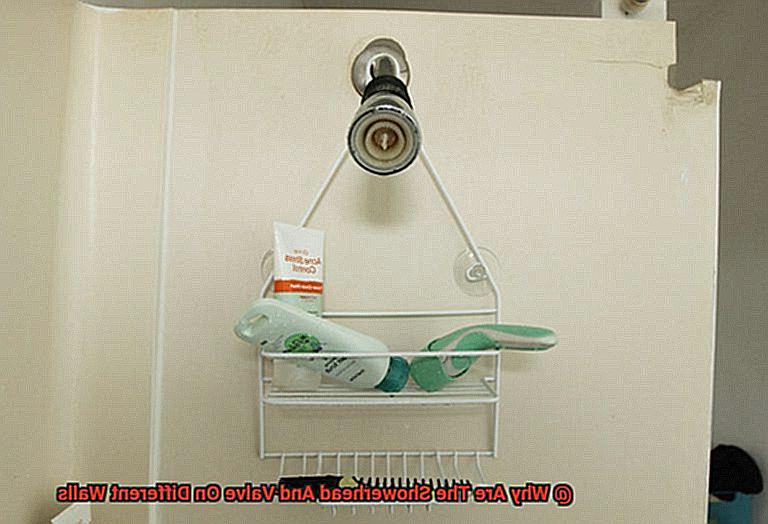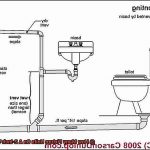Have you ever stepped into your bathroom for a refreshing shower and wondered why the showerhead and valve are on different walls? If you’re one of those curious souls, get ready for an intriguing article that will leave you enlightened.
The placement of these essential plumbing fixtures goes beyond just architecture – it has a deeper purpose. Bathrooms in modern homes prioritize functionality and aesthetic appeal, which is why the showerhead is adjacent to the bath area while the valve is on the opposite wall.
Contrary to popular belief, separating the showerhead and valve isn’t just about saving space; it’s also about preventing scalding or burning accidents. The valve controls water flow and temperature, making it easy to adjust while you shower. By having it on the opposite wall, you’re kept away from direct contact with hot water that could cause accidental burns.
But that’s not all – this design choice also provides visual symmetry, making your bathroom appear more balanced and elegant. So if you want to learn more about why your showerhead and valve are on different walls, keep reading to discover fascinating facts about modern bathroom fixture architecture and functionality.
Contents
Practicality and Safety
When it comes to bathroom design, there are two factors that are essential to consider: practicality and safety. And there’s one small detail that can make a big difference in achieving both – the placement of the showerhead and valve.
You might be wondering why your contractor insists on placing them on different walls, but there are practical reasons for this. For starters, it allows for better water control. With the valve located on a separate wall from the showerhead, it’s easier to adjust the water temperature and flow without getting wet. This can be especially helpful for those who have difficulty reaching up to adjust the showerhead while standing in the shower.
But practicality isn’t the only consideration. Safety is also crucial when it comes to bathroom design. By having the showerhead and valve on separate walls, it can help prevent accidental burns from hot water. This is because you can turn on the water from a safe distance before entering the shower, allowing time for the temperature to adjust.
In addition, separate wall installation also allows for more control over water pressure and temperature. This is especially important for households with children or elderly individuals who may require specific settings for safety reasons.
Another advantage of separate wall installation is ease of maintenance. With each component accessible from a different side, it makes it easier to access each component for repairs or replacements without disrupting the other.
Lastly, personal preference and style play a role in this decision too. Some people prefer a more symmetrical look in their bathroom design, while others may want to create a focal point with their showerhead by placing it on a specific wall.
Better Water Control
It may seem like a small detail, but it can make a world of difference in terms of practicality, safety, and ease of maintenance.
One of the primary benefits of having your valve on a separate wall is that it allows for better control over the water flow and temperature. This is especially useful if you have multiple showerheads or body sprays. With the valve on a separate wall, you can adjust the water flow and temperature without having to reach through the stream of water coming from the showerhead. This not only makes it easier to use but also reduces the risk of being scalded by hot water.
Another advantage of separating your showerhead and valve onto different walls is that it provides more convenience and safety during maintenance and repairs. Rather than having to tear apart the showerhead or cut holes in the wall to access the valve, it can be easily reached and repaired without disrupting the rest of the shower system.
Overall, having your showerhead and valve installed on different walls offers many benefits such as better water control, safety, convenience, and ease of maintenance. It’s a small detail that can make a big impact on your daily shower routine, so consider this option when designing your bathroom for a more enjoyable and efficient experience.
Prevention of Accidental Burns
When it comes to installing a showerhead and valve on separate walls, preventing accidental burns should be at the top of your list. Scalding hot water can cause painful burns that can be especially dangerous for vulnerable individuals like children and the elderly. So, what can you do to prevent accidental burns? Let’s dive in.

First and foremost, it is crucial to install anti-scald devices like thermostatic mixing valves (TMVs) or pressure-balancing valves (PBVs). These devices regulate the temperature of the water and prevent sudden changes that can lead to burns.
TMVs mix hot and cold water to achieve a consistent temperature, while PBVs regulate water pressure to maintain a constant temperature. By installing these devices, you can ensure that everyone in your household can enjoy a safe and comfortable shower experience.
Another important step is to set the maximum temperature of your water heater to 120 degrees Fahrenheit or lower.
This ensures that the water never gets too hot and reduces the risk of accidental burns. It’s also vital to test the water temperature before entering the shower or bath.
This is especially important if you have children or elderly individuals in your household who may be more sensitive to hot water.
Plumbing Considerations
When it comes to creating a bathroom that is functional and efficient, plumbing considerations are essential. One of the most important factors to consider is the placement of the showerhead and valve. While it may seem like a small detail, choosing to have them on different walls can provide several benefits that make it a popular choice in modern homes.
First and foremost, installing the showerhead and valve on separate walls makes it easier to access and maintain the plumbing system. Instead of having to access the backside of the wall for repairs or upgrades, plumbers can work from the front without causing any damage to the surrounding areas. This not only saves time but also reduces costs associated with repairs.
Another significant advantage of this design choice is the increased flexibility it provides when designing your bathroom layout. With the freedom to choose where your showerhead and valve will be located, you can create a space that best suits your needs and preferences. Whether you want a spacious shower area or a compact design, this option allows you to customize your bathroom to your liking.
Lastly, having the showerhead and valve on different walls can minimize water damage caused by leaks. If both were located on the same wall, any leaks could potentially cause significant damage to surrounding areas. However, with separate placement, any leaks are contained to a specific area, making it easier to identify and fix the issue before it becomes a more significant problem.
When planning your bathroom renovation or remodel, it’s essential to consider separate placement for your showerhead and valve. Not only does this provide practical benefits such as ease of maintenance and reduced potential for water damage, but it also allows for greater design flexibility.
Design Preference
When it comes to bathroom design, every element counts, including the placement of your showerhead and valve. You might not think much about it at first, but where you position these fixtures can make a significant difference in both the appearance and functionality of your space.
One design preference that many homeowners and designers opt for is separating the showerhead and valve onto different walls. Not only does this offer an aesthetically pleasing, streamlined look, but it also provides more flexibility for showerhead placement. With the valve on a separate wall, you’re not limited by its location when deciding where to install your showerhead.
Beyond its visual appeal, having the showerhead and valve on different walls offers practical advantages as well. One of the most significant benefits is easier maintenance access. When the valve is located behind the same wall as the showerhead, fixing a leak or addressing other issues can require tearing out tile or other materials. But with them separated, you can access the valve quickly and easily without any additional hassle.
Another advantage of keeping these fixtures on separate walls is preventing water damage. If your valve is behind the same wall as your showerhead, any leaks or water damage could potentially spread to that wall. But if they are separated, any possible leaks will be contained to just one wall.
Overall, this design preference has become popular for good reason. It offers both practical and aesthetic benefits that can make a significant impact on the functionality and appearance of your bathroom.
Conclusion
To sum it up, the placement of showerheads and valves on different walls is not just about looks. It serves a practical purpose that prioritizes safety, convenience, and ease of maintenance. By separating the valve from the showerhead, you can have better control over water temperature and prevent accidents like scalding or burning. This feature is especially crucial for households with children or elderly individuals who require specific settings to stay safe.
Moreover, having separate wall installation makes maintenance and repairs more manageable as each component is easily accessible without disturbing the other. Additionally, it adds visual symmetry to your bathroom design while making it look more elegant and balanced.
When designing your bathroom, remember to prioritize practicality and safety alongside personal style preferences. Separating the showerhead and valve onto different walls provides maximum comfort and convenience while minimizing risks. The small detail can make a significant impact on your daily shower routine, so consider this option for a more enjoyable and efficient experience.
Separating the showerhead and valve onto different walls offers numerous benefits such as better water control, safety measures, convenience during maintenance or repairs, flexibility in design preference while preventing accidental burns.






